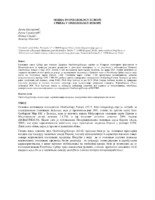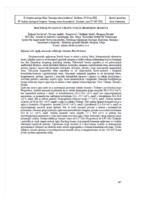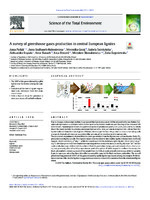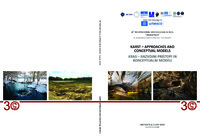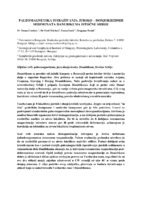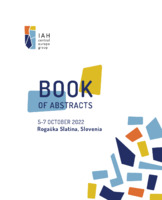Претрага
245 items
-
Tectonothermal evolution of an asymmetric extensional system: the Juhor Mts in Central Serbia (Northern Serbomacedonian massif)
Miloš Radonjić, Uroš Stojadinović, Elco Luijendijk, Dejan Radivojević, Željko Golubović, Nikola Vuković (2018)... ења метамор‐ фита на Јухору што се може довести у везу са екстензионом реактивацијом контакта Српско‐ма‐ кедонског масива и Супрагетикума током миоцена. Реактивација се догодила дуж екстензионог детачмента у чијој подини се налазе метаморфити Јухора док је у повлати дошло до таложења ...
... al., 2007). The Juhor Mts in central Serbia represent an inselberg of Proterozoic to Paleozoic age amphibolite‐facies metamorphics surrounded by Miocene to Quaternary sediments of the southernmost Pannonian Basin. The Juhor Mts, together with other uplifted areas along the Morava river ...
... Field observations show striking morphological, structural, and litho‐stratigraphic contrast between the Juhor metamorphics and the adjacent Miocene to Quaternary deposits. Hence, the observed omission could infer that the later stages of deformation in the northern Serbomace‐ d ...Miloš Radonjić, Uroš Stojadinović, Elco Luijendijk, Dejan Radivojević, Željko Golubović, Nikola Vuković. "Tectonothermal evolution of an asymmetric extensional system: the Juhor Mts in Central Serbia (Northern Serbomacedonian massif)" in 17th Serbian Geological Congress, Vrnjačka Banja, 17-20 maj 2018, Srpsko geološko društvo (2018)
-
Miocenski glodari (rodentia) Srbije
Zoran Marković (2008)Zoran Marković. Miocenski glodari (rodentia) Srbije, Beograd:Rudarsko Geološki Fakultet, 2008
-
Miocenski sisari Topličke kotline (paleontološko-stratigrafska studija)
Milorad Pavlović (1965)Milorad Pavlović. Miocenski sisari Topličke kotline (paleontološko-stratigrafska studija), Beograd:Rudarsko Geološki Fakultet, 1965
-
Miocenski sisari topličke kotline (paleontološko-stratigrafska studija)
Milorad Pavlović (1965)Milorad Pavlović. Miocenski sisari topličke kotline (paleontološko-stratigrafska studija), Beograd : Rudarsko Geološki Fakultet, 1965
-
Geotehničke osobine terena u području Beograda koje izgrađuju koherentni gornjemiocenski sedimenti
Dušanka Božinović (1970)Dušanka Božinović. Geotehničke osobine terena u području Beograda koje izgrađuju koherentni gornjemiocenski sedimenti, Beograd:Rudarsko Geološki Fakultet, 1970
-
Regionalno-geološke karakteristike miocenskih sedimenata na prostoru Severnog Banata
Dejan M. Radivojević (2014)Dejan M. Radivojević. Regionalno-geološke karakteristike miocenskih sedimenata na prostoru Severnog Banata, Beograd:Rudarsko Geološki Fakultet, 2014
-
Aranđelovački i Kosmajsko-Mladenovački produktivni miocenski basen : Stratigrafsko-tektonske osobine i pojave mineralnih sirovina na osnovu površinskog promatranja i bušenja. I, II
Dragan Dolić (1965)Dragan Dolić. Aranđelovački i Kosmajsko-Mladenovački produktivni miocenski basen : Stratigrafsko-tektonske osobine i pojave mineralnih sirovina na osnovu površinskog promatranja i bušenja. I, II, Beograd:Rudarsko Geološki Fakultet, 1965
-
Srbija u OneGeology Europe
Геолошки завод Србије као носилац Пројекта ОneGeologyEurope заједно са Рударско геолошким факултетом и Министарством за природне ресурсе, рударство и просторно планирање су се укључили у међународни Пројекат OneGeology Europe у мају 2013. године у већ поодмаклој фази израде Пројекта. До краја 2013. године испунили су завршене активности које треба да доведу до пуноправног укључења у Пројекат чиме је Република Србија нашла своје место на Геолошкој карти Европе 1:1М. Геолошка карта Србије 1:1М представља компилациону односно поједностављену верзију ОГК 1:500 ...... kreénjaci,laporci, gline 23 Miocene Middle Miocene: clases and limestones Srednji miocen: Klas i kreénjaci 24 Miocene _Lower- Middle Miocene: clasts, limestones and coal kreénjaci, uglievi 25 Miocene Lower Miocene: clastites, limestones and coal uglievi 26 Miocene Miocene in general Miocen uopste Aquitanian and ...
... kreénjaci 46 Miocene Miocene-Pliocene: clases, limestones and coal ugal_ Totronianand | 5 raksh deposi CEH 1211 guts pot lreeare 49 Miocene Upper Miocene: clastites, limestones and coals ugalj Messinian sediment+limestone+coal 47 Miocene __Meotian: marls and limestones Meot laporc, kretnjaci 48 Miocene Sarmatian: ...
... limestones Sarmat Klasti i kreénjaci 20 Miocene _Middle-Upper Miocene: clasites and limestones kreénjaci fe fee 21 Miocene __Tortonian:clasttes and limestones Torton: klastt i kreénjaci 8 6 Marine clastic rocks 122312 gupri3 pi 1244 Serravalian sediment+coal 22 Miocene __Helvetian: limestones, marls and clays ...Danka Blagojević, Ranka Stanković, Petar Stejić, Velizar Nikolić. "Srbija u OneGeology Europe" in Zapisnici Srpskog geološkog društva za 2013. godinu, Beograd : Srpsko geološko društvo (2014)
-
Composition of organic matter and thermal maturity of Mesozoic and Cenozoic sedimentary rocks in East Herzegovina (External Dinarides, Bosnia and Herzegovina)
This paper presents the first data on the organic matter and thermal maturity of Mesozoic and Cenozoic sedimentary rocks in the East Herzegovina region of the External Dinarides. Representative, organic-rich samples from outcropping sedimentary rocks of different ages in the area (Triassic to Neogene) were selected and analysed. The organic matter was studied by Rock-Eval pyrolysis and under the microscope in reflected non-polarized light and incident blue light. The results obtained show the presence of different types of organic ...... (Fig. 1C). �e main sampling criteria were to include all outcropping stratigraphic units in the area from the oldest (Triassic) to the youngest (Miocene), focusing on sedimentary rocks, rich in organic matter. For the thermal maturation study, the preferred organic matter type was coaly, since it ...
... Table 1 Main output parameters of the Rock-Eval pyrolysis of the samples analysed. T – Triassic; J – Jurassic, K – Cretaceous, E – Eocene, M – Miocene; TOC – total organic carbon (wt.%), HC – hydrocarbons, S1 – free HC (mg HC/g rock) released at 300 ºC; S2 – HC generated during pyrolysis (mg HC/g ...
... (Fig. 1C). The main sampling criteria were to include all outcropping stratigraphic units in the area from the oldest (Triassic) to the youngest (Miocene), focusing on sedimentary rocks, rich in organic matter. For the thermal maturation study, the preferred organic matter type was coaly, since it is ...Nikoleta Aleksić, Aleksandar Kostić, Miloš Radonjić. "Composition of organic matter and thermal maturity of Mesozoic and Cenozoic sedimentary rocks in East Herzegovina (External Dinarides, Bosnia and Herzegovina)" in Annales Societatis Geologorum Poloniae (2021). https://doi.org/10.14241/asgp.2021.16
-
Maceralni sastav i rang uglja Ibarskog basena
Donjemiocenski ugljonosni Ibarski basen se nalazi u južnoj Srbiji. Intramontanski ektenzivni basen, izdužen u pravcu severozapad-jugoistok ispunjen je slatkovodnim sedimentima koji su formirani kao deo Dinarskog neogenog jezerskog sistema. Paleoreljef basena izgrađen je od paleozojskih amfibolskih škriljaca, sericit-hloritskih škriljaca, krečnjaka, mermera i metabazičnih stena, mezozojskih peščara, laporca, laporovitih krečnjaka, krečnjaka, dolomita, ofiolita i oligo-/miocenskih magmatskih stena. Tercijarne magmatske stene izgrađene su od oligocenskih dacito-andezita i neogenih kvarctlatita/riodacita i piroklastičnih stena. Miocenski sedimenti izgrađeni su od aluvijalnih breča, konglomerata, peščara, ...Željana Novković, Nevena Andrić -Tomašević, Vladimir Simić, Dragana Životić. "Maceralni sastav i rang uglja Ibarskog basena" in 18. Kongres geologa Srbije "Geologija rešava probleme", Divčibare, 01-04 jun 2022., Srpsko geološko društvo (2022)
-
A survey of greenhouse gases production in central European lignites
Anna Pytlak, Anna Szafranek-Nakonieczna, Weronika Goraj, Izabela Śnieżyńska, Aleksandra Krążała, Artur Banach, Ivica Ristović, Mirosław Słowakiewicz, Zofia Stępniewska (2021)... Third Ścinawa lignite seam Lower Miocene Detroxylitic PGT - W2 Turów Second Lusatian lignite seam Lower Miocene Detroxylitic PGB - W1 Bełchatów Second Lusatian lignite seam Lower Miocene Detroxylitic PGB - W2 Bełchatów Third Ścinawa lignite seam Lower Miocene Detritic A. Pytlak, A. Szafranek-Nakonieczna ...
... Lithotype KBR Kolubara Main seam Upper Miocene Xylitic VLN-W1 Velenje Main seam Pliocene Xylodetritic VLN-W2 Velenje Main seam Pliocene Detritic KNN-W1 Konin First Mid-Polish lignite seam Middle Miocene Detritic KNN-W2 Konin First Mid-Polish lignite seam Middle Miocene Detroxylitic PGT - W1 Turów Third ...
... and were formed in epeirogenic depressions from the Palaeocene up to the Upper Miocene (Fig. 1). Polish lignites repre- sent humic low rank coal. Industrial exploitation is performed mainly in the Lower and Middle Miocene formations i.e., the third Ścinawa lig- nite seam (ŚLS-3), the second Lusatian ...Anna Pytlak, Anna Szafranek-Nakonieczna, Weronika Goraj, Izabela Śnieżyńska, Aleksandra Krążała, Artur Banach, Ivica Ristović, Mirosław Słowakiewicz, Zofia Stępniewska. "A survey of greenhouse gases production in central European lignites" in Science of The Total Environment, Elsevier (2021). https://doi.org/10.1016/j.scitotenv.2021.149551
-
To what extent reactivated faults are (not) responsible for karst process: example from Serbian Carpatho-Balkanides?
Ana Mladenović, Jelena Ćalić (2023)Carpatho-Balkanides represent part of the complex Dinaric – Carpatho – Balkan orogenic system, that geomorphologically dominates the central part of the Balkan Peninsula. The existence of this orogenic system is a result of closure of the Neotethys ocean and subsequent convergence of the Adriatic microplate and the Eurasian continent, that has been still active in the recent times. Such geodynamic characteristics conditioned complex tectonic structures, multiply reactivated during Late Cretaceous and Cenozoic times. The main aim of this work ...Ana Mladenović, Jelena Ćalić. "To what extent reactivated faults are (not) responsible for karst process: example from Serbian Carpatho-Balkanides?" in Abstracts and Guide Book 30th International Karstological School "Classical Karst" Karst - Approaches and Conceptual Models, Ljubljana : Scientific Research Centre of the Slovenian Academy of Sciences and Arts (ZRC SAZU), Karst Research Institute (2023)
-
Paleomagnetic study of Jurassic-Early Cretaceus sediments in the Danibicum of Eastern Serbia
... opštem srednjem pravcu za Vardarsku zonu, sugerišući da su ove dve oblasti mogle zajedno učestvovati u CW rotaciji od oko 40° u vreme posle donjeg miocena. U cilju podrške ovog zaključka, planiraju se buduća istraživanja u oblasti koja se nalazi između Vardarske zone i Danubikuma. PALEOMAGNETIC ...
... similar to those for the Vardar zone suggesting that these two areas could have participated in a CW rotation of around 40° together, in post Early Miocene times. In order to support this conclusion, we plan to extend the research to the area situated between the Vardar Zone and the Danubicum. ...
... new overview. Tectonophysics 410, 337—365. 2. Lesić, V., Márton, E., Cvetkov, V., Tomić. D., 2011: Paleomagnetism of the Latest Oligocene – Miocene extrusive igneous rocks from the Vardar zone and from the Serbian part of the Pannonian basin. The 4th international workshop on the Neogene ...Vesna Cvetkov, Emo Marton, Vesna Lesić, Dragana Tomić. "Paleomagnetic study of Jurassic-Early Cretaceus sediments in the Danibicum of Eastern Serbia" in I Kongres geologa u Bosni i Hercegovini sa međunarodnim učešćem, Udruženje geologa u Bosni i Hercegovini (2015)
-
U-Pb zircon geochronology of the Paleogene – Neogene volcanism in the NW Anatolia: Its implications for the Late Mesozoic-Cenozoic geodynamic evolution of the Aegean
E. Yalçın Ersoy, Cüneyt Akal, Ş. Can Genç, Osman Candan, Martin R. Palmer, Dejan Prelević, İbrahim Uysal, Regina Mertz-Kraus (2017)The northern Aegean region was shaped by subduction, obduction, collision, and post-collisional extension processes. Two areas in this region, the Rhodope-Thrace-Biga Peninsula to the west and Armutlu-Almacık-Nallıhan (the Central Sakarya) to the east, are characterized by extensive Eocene to Miocene post-collisional magmatic associations. We suggest that comparison of the Cenozoic magmatic events of these two regions may provide insights into the Late Mesozoic to Cenozoic tectonic evolution of the Aegean. With this aim, we present an improved Cenozoic stratigraphy ...E. Yalçın Ersoy, Cüneyt Akal, Ş. Can Genç, Osman Candan, Martin R. Palmer, Dejan Prelević, İbrahim Uysal, Regina Mertz-Kraus. "U-Pb zircon geochronology of the Paleogene – Neogene volcanism in the NW Anatolia: Its implications for the Late Mesozoic-Cenozoic geodynamic evolution of the Aegean" in Tectonophysics 717 (2017): 284-301. https://doi.org/10.1016/j.tecto.2017.08.016
-
Late and post-collisional tectonic evolution of the Adria-Europe suture in the Vardar Zone
The Vardar Zone is a product of the Triassic-Jurassic opening of the Neotethys, Jurassic obduction, Late Cretaceous/Paleogene consumption of the oceanic crust and continental collision. During the last process, the Eastern Vardar Zone was thrust over the Central and eventually both onto the Western Vardar Zone. The present paleomagnetic and structural study provided new results from the first two zones in the Belgrade area. The younger set of data, together with published ones from the third zone, provide firm ...Emő Márton, Marinko Toljić, Vesna Cvetkov. "Late and post-collisional tectonic evolution of the Adria-Europe suture in the Vardar Zone" in Journal of Geodynamics, Elsevier BV (2022). https://doi.org/10.1016/j.jog.2021.101880
-
Hydrochemical indicators of groundwater flow in the area of “Čukaru Peki” Cu-Au underground mine in eastern Serbia
The physical and chemical properties of groundwater, together with the groundwater levels regime and rock hydraulic properties, are often used to understand and conceptualize the hydrogeological system. Prediction of the influence of mining works on groundwater, and vice versa, is a challenge due to significantly altered groundwater flow patterns in the raw materials exploitation areas in relation to natural conditions. Therefore, multiple parameters are assessed and monitored before and during exploitation to properly characterize and quantify the system for ...Nebojša Atanacković, Vladimir Živanović, Jana Štrbački, Veselin Dragišić, Ivana Cvejić. "Hydrochemical indicators of groundwater flow in the area of “Čukaru Peki” Cu-Au underground mine in eastern Serbia" in 5th IAH CEG conference, Slovenian Committee of International Association of Hydrogeologists - SKIAH (2022)
-
Tektonska evolucija ugljevičkog basena (Bosna i Hercegovina)
Slobodan Dragić (2024)U radu je prezentovana šira slika tektonske evolucije ugljevičkog basena, kao i Dinarida uopšte. Prikazani su litostratigrafski odnosi istraživanog područja, kao i kratak pregled tektonskih jedinica koje se nalaze u domenu basena. Najveća pažnja posvećena je kinematskoj analizi rasjednih struktura i interpretaciji podataka u svjetlu tektonske evolucije basena. Ugljevički basen zapunjen je oligocensko-miocenskim sedimentima, a njegovu osnovu grade paleozojsko-mezozojske formacije. Najstarije tvorevine na ovom području su permski sedimenti. Trijaski i kredni deponati, uglavnom krečnjaci, reprezent su tvorevina ...... odnosno „Ugljevik-Istok“ (Ui-41 i Ui-43) dokumentovano je postojanje transgresivnog i diskordantnog odnosa između slatkovodnog donjeg miocena ı morskog srednjeg miocena. Osnovni kriterijum za izdvajanje morskih sedimenata je prisustvo morskih fosila kao što su foraminifere, ostrakode i ribe pronađene ...
... basen. Ovaj basen Je započeo evoluciju tokom oligocena i ranog miocena. Na njega je uticala asimetrična ekstenzija velikih razmjera koje je dovelo do taloženja 2 km kontinentalnih aluvijalnih do deltnih sedimenata srednjeg i gornjeg miocena (Andrić et al., 2017). U radu van Unen (2019) navodi da ...
... basena se nastavila tokom gornjeg miocena sve do prije 8 miliona godina kada je područje Karpatske subdukcione zone izloženo kompresiji (Balazs et al., 2016; Matenco & Radivojević, 2012). Dakle, ekstenzija je praćena inverzijom koja je započela tokom kasnog miocena i trenutno je aktivna. Ova oblikovanja ...Slobodan Dragić. Tektonska evolucija ugljevičkog basena (Bosna i Hercegovina), 2024
-
Geološke karakteristike neogenih sedimenta na prostoru šire okoline Ledinaca
Aleksandar Tričković (2024)Sagledavanje evolucije neogenih sedimenata na prostoru šire okoline sela Ledinci omogućeno je primenom različitih stratigrafskih metoda na površinskim i potpovršinskim podacima. Za izradu rada korišćene su sedimentološke, biostratigrafske, geofizičke i riftno sekvencione metode, koje su primenjene na površinskim izdancima i bušotinama. Primenom principa riftne sekvencione stratigrafije na podacima dobijenim geofizičkim karotažnim merenjima dobijeni su podaci o vremenu ekstenzije u Panonskom basenu. Pored toga ovi podaci zajedno sa sedimentološkim i stratigrafskim metodama omogućili su izdvajanje depozicionih sredina tokom neogena. Generalno ...depozicioni sistemi, neogen, Panonski basen, ekstenzija, formacije, riftna sekvenciona stratigrafija... otvaranja basena počela je tokom miocena pre 20 miliona godina i dešavala se uporedo sa izdizanjem Dinarida (Matenco & Radivojević 2012). Ekstenzijom dolazi do formiranja velikog broja gravitacionih raseda u kojima se deponuju kontinentalne naslage donjeg miocena. Dalja evolucija se može podeliti ...
... izolacije Panonskog i Dakijskog basena. Na osnovu potpovršinskih podataka sa tačke 10, južno od Dunava početna faza rifta se vezuje za donji miocen. Donji miocen je grubozrnog karaktera, sa glinovitim vezivom crvene boje. Klastični sedimenti badenske starosti koji se nalaze na terenu u okolini Rakovca ...
... koje su prošle kroz polifaznu evoluciju, obdukciju ofiolita tokom jure, krednu koliziju Evrope i Adrije 1 ekstenziju i inverziju basena tokom miocena (Toljić et al. 2013). Generalno posmatrano tereni Fruške gore pripadaju Dinaridima koji su pokriveni sedimentima Panonskog basena. U užem smislu ...Aleksandar Tričković. Geološke karakteristike neogenih sedimenta na prostoru šire okoline Ledinaca, 2024
-
The Rift Sequence Stratigraphy of the Itebej Field (Pannonian Basin, Serbia)
... pre-rift stage is marked by unconformity at the bottom of Miocene sediments. The rift initiation system tract was confirmed by several wells which drilled coarse siliciclastic sediments of the Early Badenian age. During the Middle Miocene after the early syn-rift stage, a “wide-rift” stage (Tari ...Saša Ivanišević, Jelena Radišić, Ivana Isić, Dejan Radivojević. "The Rift Sequence Stratigraphy of the Itebej Field (Pannonian Basin, Serbia)" in AAPG Vienna, Paratethys petroleum systems between Central Europe and the Caspian Region, Vienna, 26-27 mart, 2019, AAPG (2019)
-
Hydrogeochemistry of Uranium in the Groundwaters of Serbia
Marina Ćuk, Maja Todorović, Petar Papić, Jovan Kovačević, Zoran Nikić. "Hydrogeochemistry of Uranium in the Groundwaters of Serbia" in Uranium - Past and Future Challenges, Springer International Publishing Switzerland (2015). https://doi.org/10.1007/978-3-319-11059-2_89


